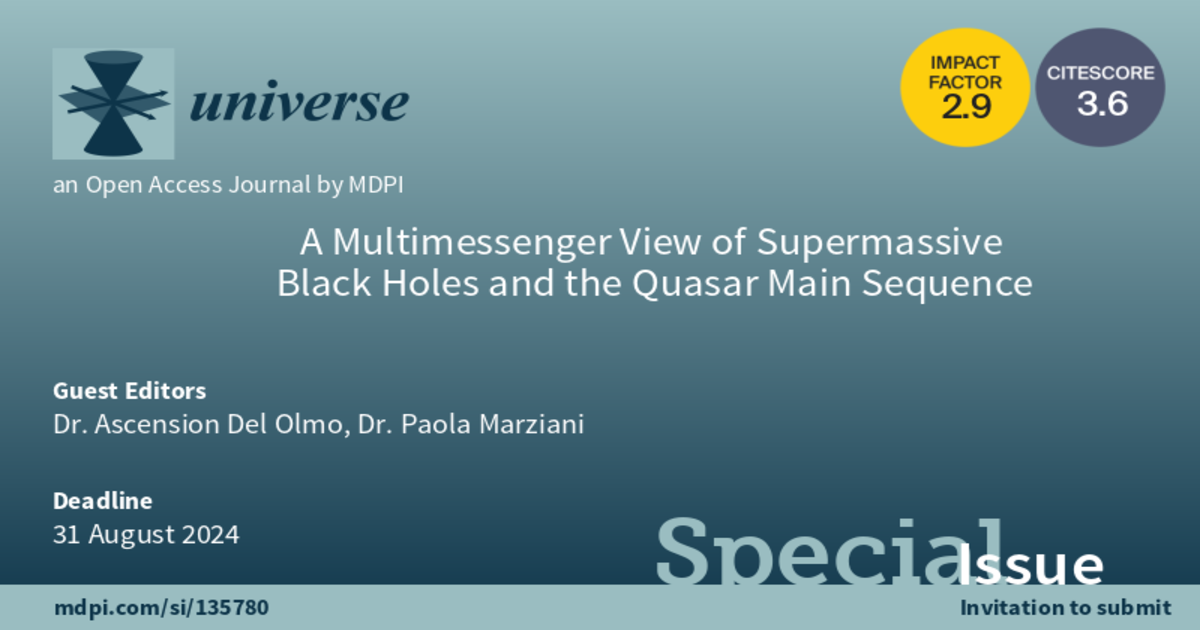A Multimessenger View of Supermassive Black Holes and the Quasar Main Sequence
A special issue of Universe (ISSN 2218-1997). This special issue belongs to the section "Galaxies and Clusters".
Deadline for manuscript submissions: 31 August 2024 | Viewed by 7978

Special Issue Editors
Interests: AGN; groups of galaxies; extra-galactic astronomy
Interests: quasars and Active Galactic Nuclei (AGN); photoionization and dynamical modelling of gaseous regions producing emission lines in a variety of contexts (from emission line stars to the most powerful quasars); small and large scale structures in the Universe and observational cosmology
Special Issue Information
Dear Colleagues,
The last 30 years has seen a major step forward in the analysis of optical and UV spectroscopic data of large quasar samples. It is an important achievement that the main empirical correlates can now be organized along what has become known as the Eigenvector 1 “main sequence” (MS) of quasars. The current research is oriented toward the definition and the expansion of the MS correlates, as well as to the exploitation of the MS systematic trends as a basic input to physical and dynamical modelling of the quasar structure, including the accretion disk structure. Nowadays, it has become widely accepted that the main physical parameter governing the sequence is Eddington ratio, i.e., the ratio between AGN luminosity and black hole mass or equivalently, between radiation and gravitation forces—a parameter that for AGN takes the role of mass for stars. This means that a number of applications have become possible, among them the estimate of the accretion disk wind properties and of the metal enrichment in large samples of AGN, and, finally, the use of quasars as high-redshift distance indicators. The present Special Issue is aimed to host several contributions (both theoretical and observational) dealing with diverse aspects related to the main sequence at the frontier of research on AGN.
Potential topics include, but are not limited to:
- The quasar Eigenvector 1/main sequence;
- Accretion disk structure and connection with observational multi-frequency properties;
- The broad line emitting region;
- AGN winds at all frequencies and powers;
- The host-galaxy/active nucleus connection: star formation and metal enrichment;
- The radio loud/radio quiet dichotomy;
- The evolution of accreting black holes across cosmic times;
- Intrinsic luminosity effects and quasars as cosmological standard candles.
Dr. Ascension Del Olmo
Dr. Paola Marziani
Guest Editors
Manuscript Submission Information
Manuscripts should be submitted online at www.mdpi.com by registering and logging in to this website. Once you are registered, click here to go to the submission form. Manuscripts can be submitted until the deadline. All submissions that pass pre-check are peer-reviewed. Accepted papers will be published continuously in the journal (as soon as accepted) and will be listed together on the special issue website. Research articles, review articles as well as short communications are invited. For planned papers, a title and short abstract (about 100 words) can be sent to the Editorial Office for announcement on this website.
Submitted manuscripts should not have been published previously, nor be under consideration for publication elsewhere (except conference proceedings papers). All manuscripts are thoroughly refereed through a single-blind peer-review process. A guide for authors and other relevant information for submission of manuscripts is available on the Instructions for Authors page. Universe is an international peer-reviewed open access monthly journal published by MDPI.
Please visit the Instructions for Authors page before submitting a manuscript. Submitted papers should be well formatted and use good English. Authors may use MDPI's English editing service prior to publication or during author revisions.
Keywords
- quasars
- active galactic nuclei
- supermassive black holes
- quasar main sequence
Planned Papers
The below list represents only planned manuscripts. Some of these manuscripts have not been received by the Editorial Office yet. Papers submitted to MDPI journals are subject to peer-review.
1. Carolina Andoine
2. Alberto Rodriguez Ardila
3. Erika Benítez
4. Andjelka Kavacevic
5. Dragana Ilic
6. Luka Popovic
7. Ascension Del Olmo
8. Paola Marziani






